Interactive Brokers shares jump as it secures spot in S&P 500
Introduction & Market Context
Halliburton Company (NYSE:HAL) recently presented its fourth quarter 2024 results, highlighting the company’s strategic positioning amid evolving market conditions in the global energy sector. The presentation, delivered in early 2025, showcased how the oilfield services giant is navigating regional variations in demand while maintaining its focus on technological innovation and shareholder returns.
With operations spanning more than 70 countries and employing over 48,000 people from 145 nationalities, Halliburton continues to leverage its extensive global footprint to balance growth opportunities across diverse markets. Recent market data shows the company’s stock trading at $21.24, up 4.32% from its previous close, but still facing challenges following a significant decline after its Q1 2025 earnings release.
As shown in the following global operations map, Halliburton maintains a substantial international presence that has become increasingly important to its financial performance:
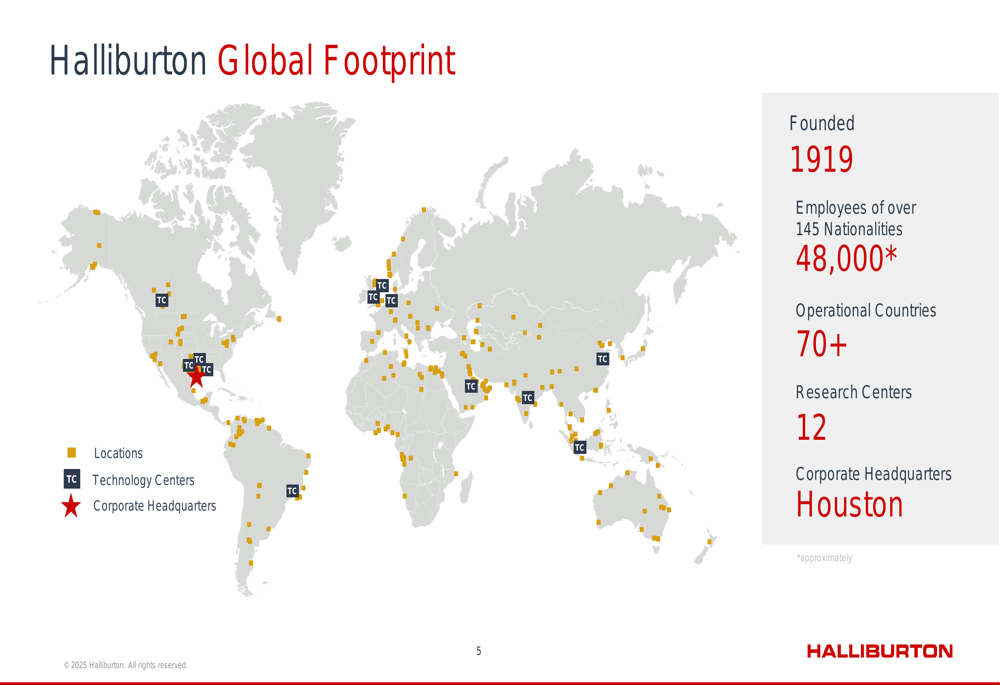
Quarterly Performance Highlights
Halliburton’s Q4 2024 results revealed a shifting geographic revenue mix, with international markets accounting for 60% of total revenue while North America contributed 40%. This represents a strategic pivot as the company continues to pursue growth opportunities outside its traditional North American stronghold.
The company’s international revenue performance has significantly outpaced the international rig count, with the international revenue index reaching 132 in Q4 2024 (from a base of 100 in Q1 2020) while the international rig index stood at only 86. This demonstrates Halliburton’s ability to extract more value per rig in international markets.
The geographic revenue breakdown for Q4 2024 shows mixed performance across regions:
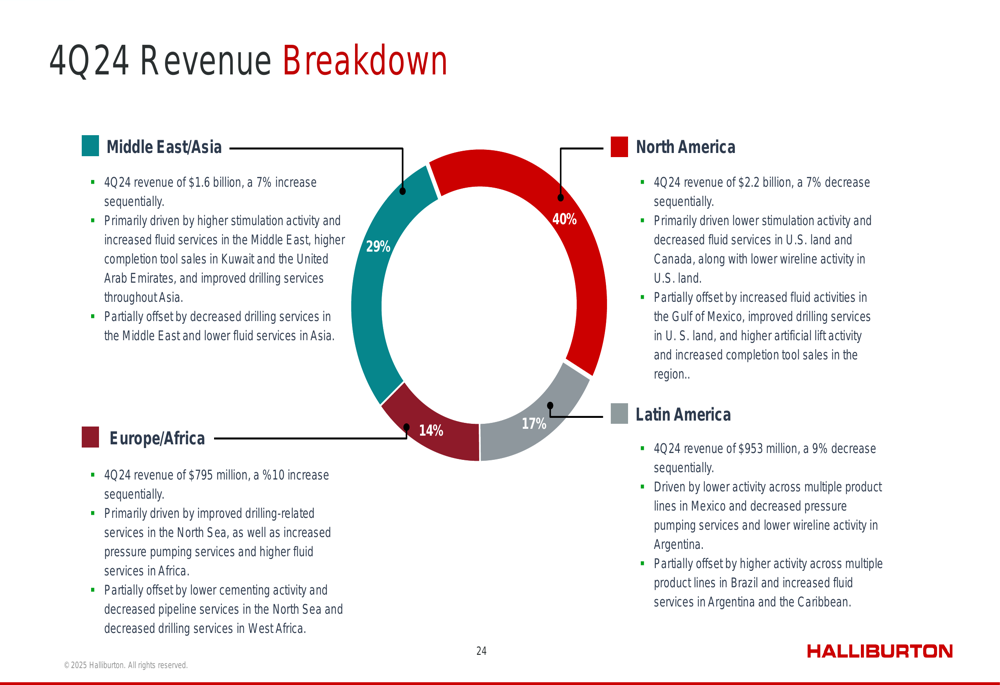
Middle East/Asia led growth with $1.6 billion in revenue (7% increase), while Europe/Africa contributed $795 million (10% increase). Conversely, North America revenue declined 7% to $2.2 billion, and Latin America fell 9% to $953 million. These regional variations reflect the complex and evolving dynamics of global energy markets.
The company’s financial metrics demonstrate solid performance despite these regional challenges:
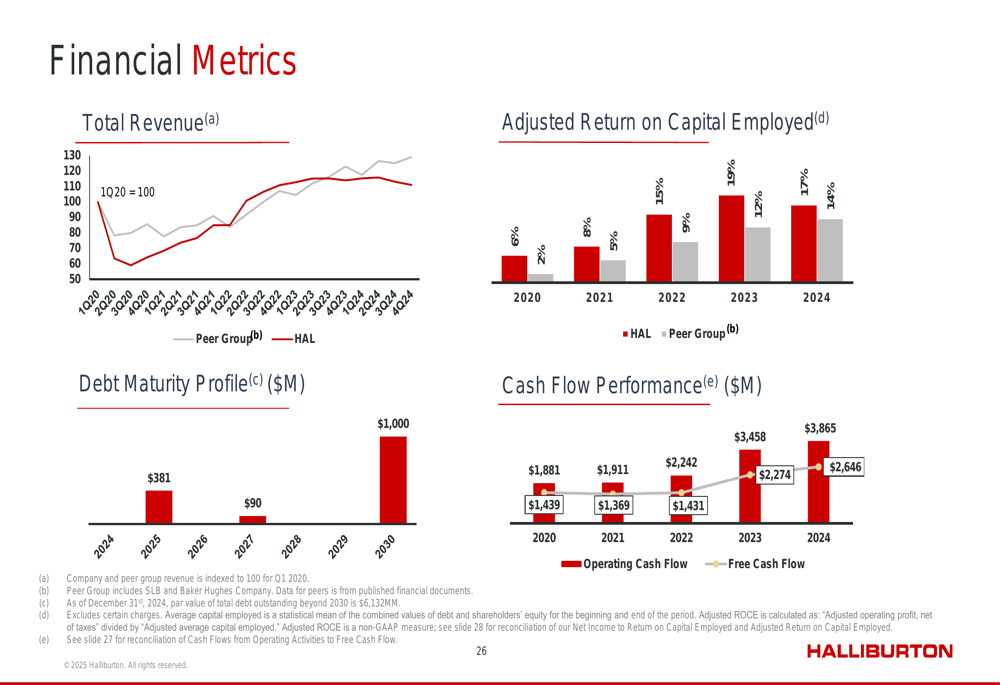
Strategic Initiatives
Halliburton’s presentation emphasized five key strategic priorities designed to deliver industry-leading returns and strong free cash flow for shareholders:

The company’s focus on profitable international growth has been particularly successful, as evidenced by the outperformance of international revenue relative to rig count. This strategy is supported by Halliburton’s technological leadership, with platforms like iCruise (Intelligent Rotary Steerable System), iStar (Intelligent Drilling & Logging Platform), and LOGIX (Autonomous Drilling Platform) providing competitive advantages in drilling operations.
As illustrated in the following slide, these advanced drilling technologies are central to Halliburton’s value proposition:

In North America, where market conditions have been more challenging, Halliburton is focusing on maximizing value through innovative technologies like the Zeus Electric Fracturing System. This system combines grid power solutions with natural gas reciprocating engines to improve efficiency and reduce environmental impact:

Financial Analysis
Halliburton’s financial performance in 2024 demonstrated the company’s commitment to capital efficiency and shareholder returns. Free cash flow reached $2,646 million for the full year 2024, representing a 16% increase from $2,274 million in 2023 and continuing a strong upward trend from $1,369 million in 2021.
The company has maintained capital expenditures at 5-6% of revenue through equipment design enhancements, new materials, higher asset velocity, digital technologies, and a changing portfolio mix. This disciplined approach to capital allocation has supported the strong free cash flow generation:
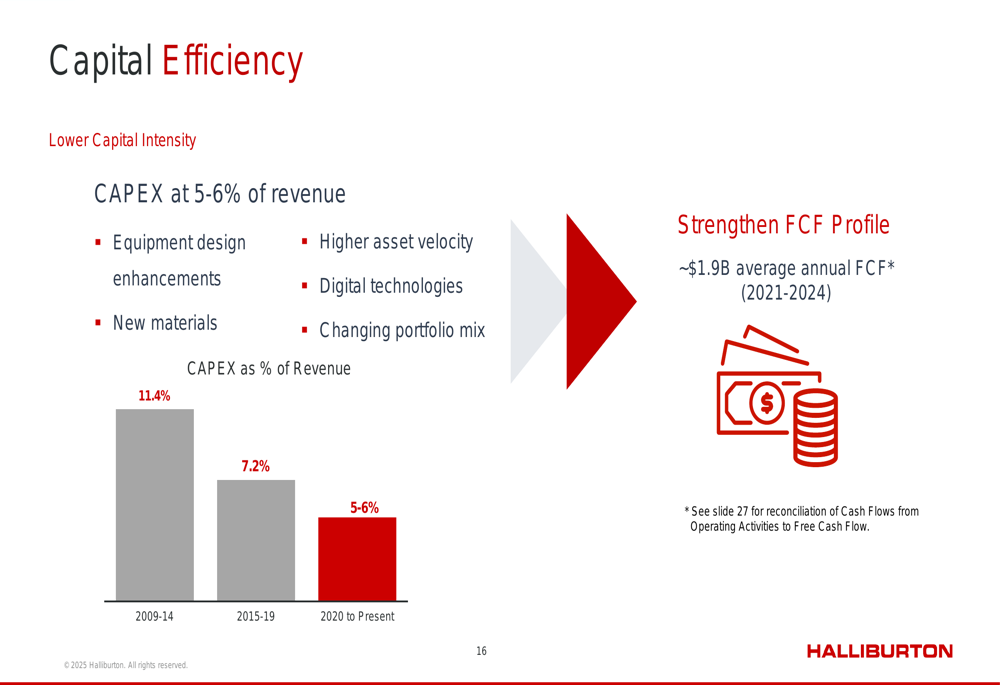
Return on capital employed (ROCE) has shown significant improvement over recent years, though with a slight decline in 2024. Adjusted ROCE stood at 17% in 2024, down from 19% in 2023 but still substantially higher than the 6% recorded in 2020.
Halliburton’s shareholder return framework commits to returning at least 50% of annual free cash flow to shareholders through dividends and share repurchases. The company increased its quarterly dividend to $0.17 per share in Q1 2024 and repurchased approximately $1 billion in shares during 2024, with approximately $3.0 billion in repurchase authorization remaining:
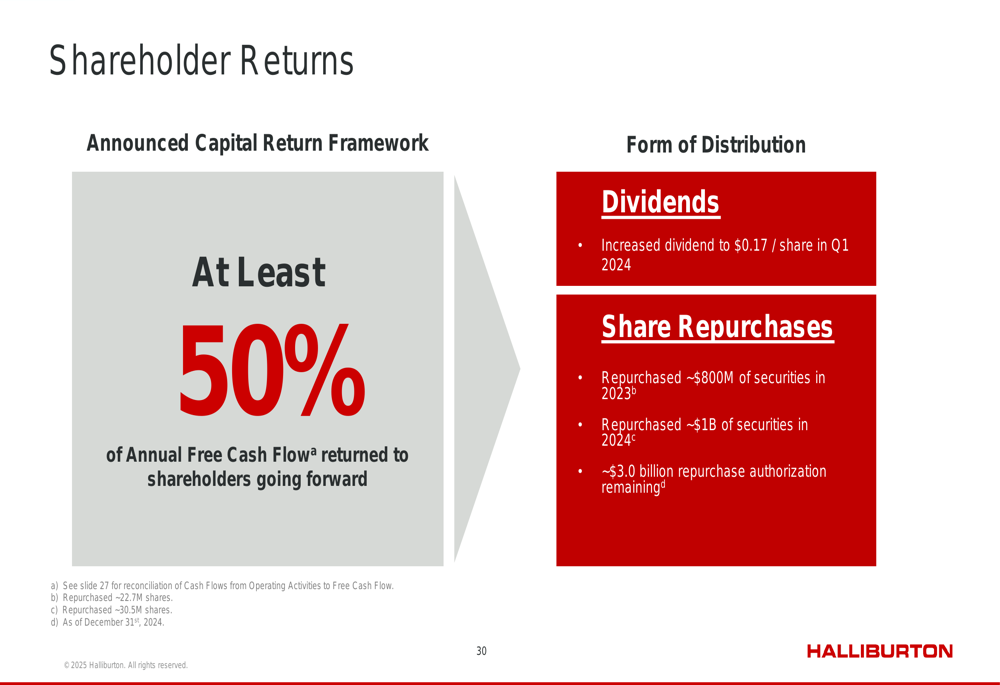
Forward-Looking Statements
Looking ahead, Halliburton faces both opportunities and challenges. While the Q4 2024 presentation painted an optimistic picture of the company’s strategic positioning, subsequent Q1 2025 results revealed some headwinds. The company reported a 7% year-over-year decrease in revenue for Q1 2025, with earnings per share slightly missing expectations at $0.60 compared to the forecast of $0.61.
Halliburton anticipates flat to slightly down international revenue for 2025, with solid free cash flow expected despite market uncertainties. The company remains committed to its capital return framework, planning to return at least $1.6 billion to shareholders in the coming year.
Environmental sustainability remains a strategic focus, with Halliburton targeting a 40% reduction in scope 1 and 2 emissions by 2035 from a 2018 baseline. This commitment is supported by a comprehensive GHG inventory system, data-based reduction initiatives, and transition opportunities focused on customer solutions and geothermal projects.
CEO Jeff Miller emphasized the fundamental role of oil and gas in global economic growth during the Q1 2025 earnings call, stating, "Oil and gas will play a fundamental role in global economic growth and prosperity." He also highlighted the company’s strategic capital allocation, noting, "We are allocating capital to those things that are growing."
As Halliburton navigates the evolving energy landscape, its diversified geographic presence, technological leadership, and financial discipline position the company to manage market volatility while delivering value to shareholders.
Full presentation:
This article was generated with the support of AI and reviewed by an editor. For more information see our T&C.
